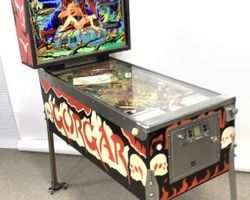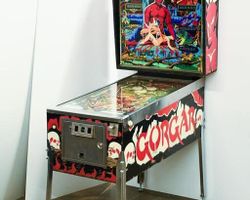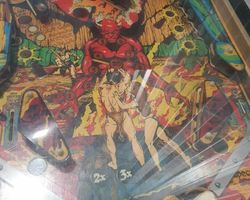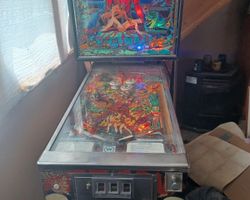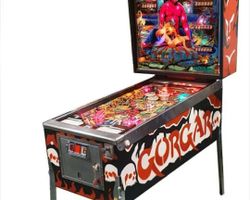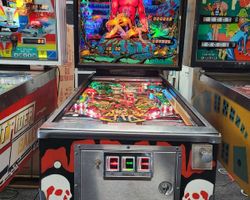Gorgar
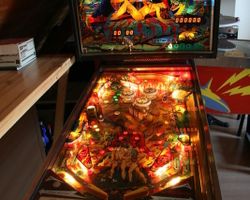
Average Prices: USD $300 to $1,500
Produced: December, 1979
Production Run: 14,000 units
Machine Type: Solid State Electronic
MPU: Williams System 6
Players: 4
Design by: Barry Oursler
Art by: Constantino Mitchell
Emerging from the creative workshops of Williams Electronics, Incorporated, Gorgar hit arcades in December 1979, marking a pivotal moment in pinball history. This solid-state electronic machine, was not just another addition to the pinball landscape; it was a technological and thematic departure. Conceived under the Williams System 6 platform, Gorgar was the brainchild of designer Barry Oursler, with evocative artwork crafted by Constantino and Jeanine Mitchell, and software and speech processing expertly handled by Paul Dussault and Eugene Jarvis, respectively.
Gorgar's thematic inspiration delves into a realm of dark fantasy, populated with monsters and demonic imagery. This macabre theme is immediately apparent in the artwork adorning the cabinet, backglass, and playfield, setting a tone distinct from the lighter, more conventional themes prevalent at the time. The game's development coincided with Williams' exploration of speech technology in pinball. Intriguingly, a talking prototype was showcased as early as 1978 with 'Disco Fever', although Gorgar became the first commercially released talking pinball machine. Unveiled to significant acclaim at the 1979 AMOA Expo in Chicago, Gorgar represented a production-ready marvel. Production commenced in late November 1979 and continued until March 1980, culminating in a confirmed run of 14,000 units. Interestingly, while the talking feature was initially offered as an optional upgrade for operators at an additional cost, it proved immensely popular, becoming a defining characteristic of the machine.
Signature Features and Design
Gorgar's most distinguishing feature is undeniably its voice. Boasting a vocabulary of seven words, including the iconic phrase "Gorgar speaks!", it was the first pinball machine to commercially integrate speech. This auditory element was complemented by a heartbeat sound effect that dynamically intensified as gameplay progressed, heightening the tension and immersion. Beyond the groundbreaking speech, the game incorporates a 'Snake Pit' mechanism, utilizing a magnet beneath the playfield to capture and hold the ball, adding a layer of strategic depth to ball control.
The artwork of Gorgar is a signature element, immersing players in its dark fantasy world. The playfield, backglass, and cabinet art are rendered in vivid colors and intricate detail, depicting demonic figures and scenes that evoke a sense of danger and mystique. The visual style shares a striking resemblance to the fantasy art of Boris Vallejo, particularly his 1978 piece "In the Underworld", suggesting a clear artistic influence. This aesthetic choice was bold, contributing significantly to Gorgar's unique identity and appeal, particularly for players drawn to darker, more mature themes.
Playfield and Mechanics
The Gorgar playfield is a study in classic pinball layout design, effectively blending familiar elements with unique features to create a compelling gameplay arena. It features a symmetrical arrangement with two flippers at the bottom, navigating shots towards three pop bumpers positioned centrally, and two slingshots flanking the flippers. Key playfield components include two banks of 3-drop targets, strategically placed to challenge shot accuracy and reward skillful play. A central spinner adds to the kinetic energy of the playfield, registering points and enhancing the pace of the game. Four standup targets are incorporated, providing additional scoring opportunities and objectives. The 'Snake Pit' kick-out hole, marked prominently on the playfield, is a central focus, activating the under-playfield magnet to capture the ball, holding it momentarily while scoring is calculated, before releasing it back into play.
The playfield artwork is integrated seamlessly with the mechanical elements. Vibrant illustrations of monstrous figures and serpentine forms surround the targets and lanes, reinforcing the game's thematic narrative. Lighting is used to highlight key areas and features, drawing attention to active targets and enhancing the visual drama of the gameplay. The overall aesthetic of the playfield is designed to be both visually striking and functionally clear, guiding the player's eye and encouraging engagement with the various shots and targets. The layout promotes a flow that is both challenging and rewarding, encouraging players to master the shot angles and understand the mechanics of the Snake Pit to maximize their scores.
Gameplay Dynamics
Gorgar's gameplay is characterized by its direct and challenging mechanics. The core objective revolves around skillful shot execution to hit drop targets, activate bumpers, and spin the spinner, all while navigating the ever-present threat of drains. The game lacks complex modes or multiball features common in later pinball designs, instead focusing on a fundamental pinball experience centered on ball control and accurate shooting. The scoring system is straightforward, rewarding successful shots and target completions with escalating point values. The heartbeat sound effect acts as an organic timer, increasing in tempo as the game progresses, adding a subtle but effective pressure element to each ball.
The Snake Pit is a pivotal gameplay element. Successfully shooting the ball into the Snake Pit triggers the magnet, holding the ball briefly and awarding points based on lit values. This feature introduces a risk-reward dynamic; accurate shots to the Snake Pit can yield significant points, but missed shots can easily lead to drains due to the proximity of the outlanes. The drop targets, arranged in A-B-C lanes on both sides of the playfield, demand precision and strategic clearing to advance gameplay and potentially increase scoring multipliers. While Gorgar’s rule set may be considered basic by modern standards, it provides a compelling and addictive gameplay loop. The challenge lies in mastering the shot angles, understanding the ball physics, and reacting quickly to the fast-paced action, making each game a test of skill and reflexes.
Reception and Legacy
Gorgar’s reception within the pinball community is multifaceted, marked by both praise and criticism. A significant point of admiration is its historical importance as the first talking pinball machine. This technological innovation is widely recognized as a landmark achievement, solidifying Gorgar's place in pinball history. The game's distinctive artwork and dark fantasy theme are also consistently lauded, appreciated for their bold aesthetic and immersive quality. Many enthusiasts express nostalgic fondness for Gorgar, remembering it as a memorable part of their early pinball experiences and valuing it as a collectible piece of pinball history.
However, feedback also highlights gameplay difficulty as a significant drawback. Gorgar is frequently described as a "drain monster" due to its unforgiving outlanes and challenging shot angles. This high drain rate can lead to frustratingly short games, particularly for less experienced players. Some critics also point to the relative simplicity of its gameplay compared to later, more complex pinball machines. The limited vocabulary of the speech and the repetitive nature of the sound effects are also sometimes mentioned as minor shortcomings.
Despite these criticisms, Gorgar's legacy is secure. It remains a sought-after machine among collectors, valued for its historical significance, unique talking feature, and striking visual design. While it may not be considered the deepest or most forgiving pinball machine in terms of gameplay, its pioneering role in integrating speech technology and its distinctive thematic presentation have ensured its enduring appeal. Gorgar stands as a testament to a pivotal era in pinball innovation, bridging the gap between classic electromechanical designs and the increasingly complex solid-state machines that would follow.
 Active Auctions
Active Auctions
 Auction Results
Auction Results
| Cost | Location | Date |
|---|---|---|
| USD $1,000 |  Minnesota, United States Minnesota, United States |
28 January, 2025 |
| USD $1,700 |  Washington, United States Washington, United States |
17 January, 2025 |
| USD $1,000 |  New York, United States New York, United States |
22 December, 2024 |
| USD $3,989 |  Florida, United States Florida, United States |
14 November, 2024 |
| USD $3,300 |  California, United States California, United States |
29 October, 2024 |
| USD $4,000 |  California, United States California, United States |
04 October, 2024 |
| USD $3,995 |  California, United States California, United States |
18 August, 2024 |
| CAD $4,000 |  Canada Canada |
08 April, 2024 |
| USD $625 |  Indiana, United States Indiana, United States |
05 December, 2023 |
| USD $2,200 |  United States United States |
24 October, 2023 |


Private Policy · Search Website · Contact Us
All trademarks and copyrighted materials remain property of their respective owners.
All other content copyright 2007 - 2025 Pinpedia.

